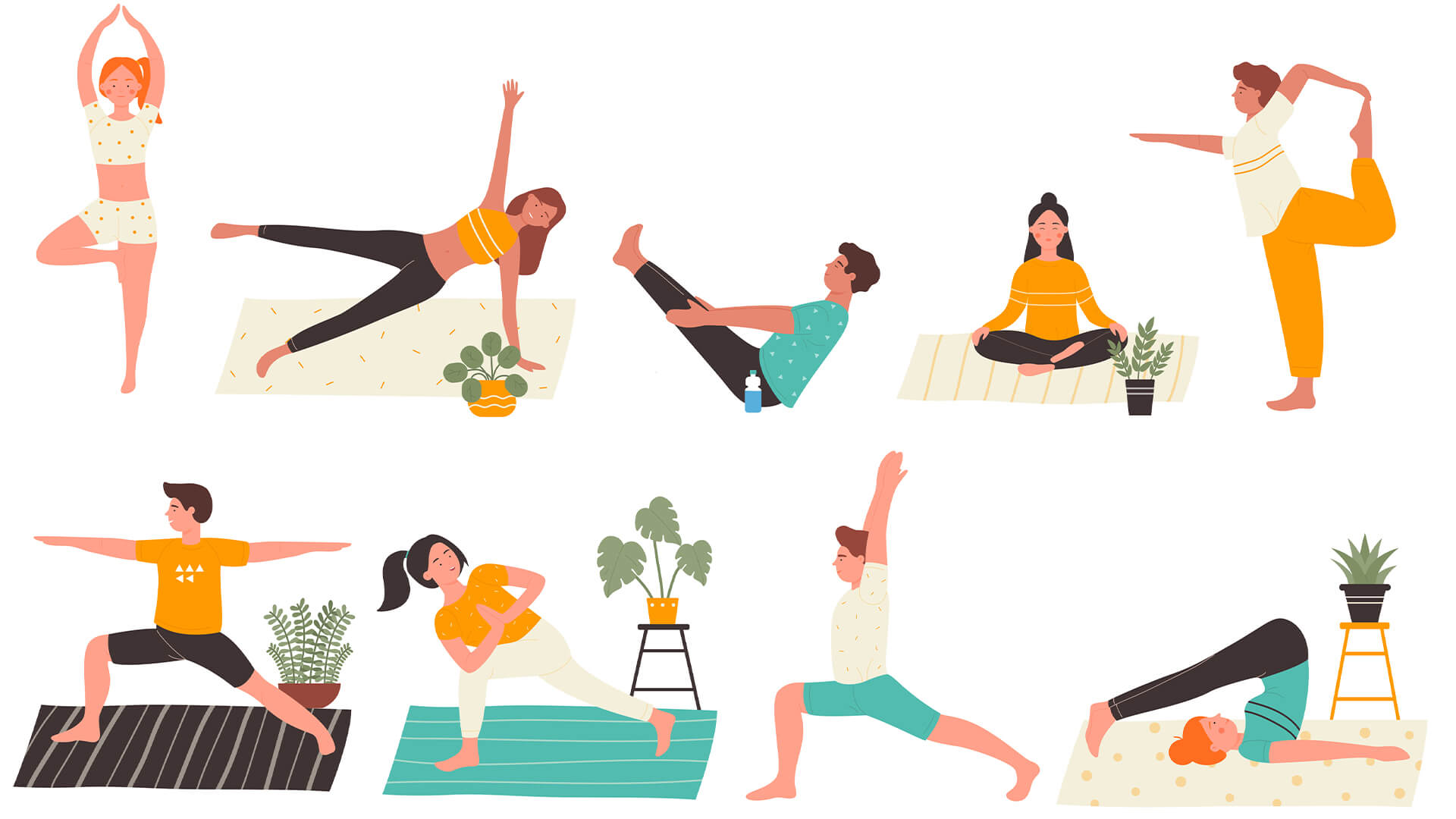As we begin to readjust to new routines following further easing of COVID restrictions, it is more important now than ever to take some time out of your busy schedule to focus on you.
A daily yoga practice can bring together your mind and body, incorporating breathing exercises, meditation and poses designed to encourage relaxation and reduce stress.
Here, Marica Carleschi, european consumer marketing manager at INNOVO, and part-time yoga instructor, discusses the many benefits of yoga including how it can give you control over bladder leaks, improve your sex life and strenghten your core muscles.
Reduce Stress
Yoga is known for its ability to relieve stress and encourage relaxation by combining many popular stress-reducing techniques, including exercise, breath control, the ability to clear the mind, and relax the body.
When we’re stressed we hold a lot of tension in the body, which makes us feel tight and can cause pain in certain areas. By stretching the body we release tension from problem areas, including the hips, lower back and shoulders.
Relieve Anxiety
Many people approach yoga for different reasons, but anxiety can often be a leading factor. Yoga gives us the tools to recognise the thoughts, feelings and actions that can cause heightened anxiety and enact effective self-soothing methods.
Yoga helps us to learn how to regulate our stress response and build resilience to stress. The breath work we learn on the mat can be applied to any aspect of our lives, therefore in times of stress or heightened anxiety, taking deep meditative breaths can help us control our emotions and feel a sense of calm.
Prevent Bladder Leaks
A strong pelvic floor is essential for preventing bladder leaks. Situated in the pelvis, the pelvic floor is a key set of deep muscles that holds all of the pelvic organs (uterus, vagina, bowel & bladder) in place and supports the bladder to provide control when you urinate. Like any muscle group, these muscles need to be toned and strengthened in order for them to perform efficiently.
Yoga is hugely beneficial for your pelvic floor muscles as a lot of exercises focus on strengthening and engaging your core. Different poses encourage you to lift and squeeze, strengthening those key muscles.
Improve Your Orgasms
Not only does a strong pelvic floor prevent bladder leaks, but it is possible that strong pelvic floor muscles could increase sensitivity during sex, giving you stronger orgasms. Yoga’s relaxing effects can also provide some sexual benefits as it teaches you to focus your attention on sensations and what feelings give you pleasure.
Improve Quality of Life
A regular exercise routine has an array of benefits including a boost in self-esteem, mood, sleep quality and energy, as well as reducing your risk of stress, depression and health problems.
Yoga is the perfect exercise to help you unwind, boost your endorphins and put you first.
Essential Yoga Poses to Kickstart Your Practice
Not sure where to start with your practice? Try out these poses, perfect for beginners or full time yogis which will help you strengthen your core and target your pelvic floor.
Mountain Pose (Tadasana)
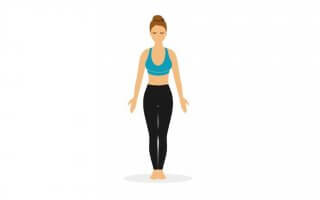
To do this exercise:
- Stand with your feet hip distance apart and your hands resting at your sides
- Place a yoga block (or a thick book or pillow) between your thighs.
- Engage your inner thighs and try to lift the block upwards.
Chair Pose (Utkatasana)
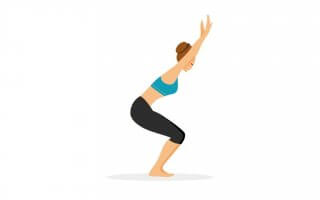
To do this exercise:
- Stand with your feet hip distance apart and your hands resting at your sides
- Stretch your arms upwards, lengthen the tips of your fingers towards the ceiling.
- Bend your knees, keeping your back as straight as possible, and push your hips back into a squat, as though you’re sitting down into a chair.
- Keep your heels connected to the floor, without your hips dipping any lower than your knees.
- Hold the posture for a couple of breaths.
- Try to lift your pelvic floor upwards, as though you were trying to hold in a wee.
- Straighten up again slowly.
- Repeat.
Warrior II (Virabhadrasana II)
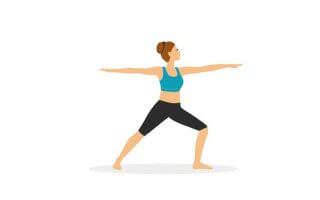
To do this exercise:
- Stand with your feet hip distance apart and your hands resting at your sides
- Step your right foot forwards (with your front & back foot about 1 metre apart).
- Lift your arms straight out to the sides so they are parallel to the floor.
- Keep your right foot straight, but turn your left foot out slightly so that your toes are pointing away from your body.
- Bend the right knee over the right ankle, keeping your left leg straight.
- Tighten your tummy as though you are pressing your belly button to your spine, and pull up the pelvic floor
- Hold for about 30 seconds, then straighten the right leg.
- Repeat.
- Try on the other side.
Happy Baby (Ananda Balasana)
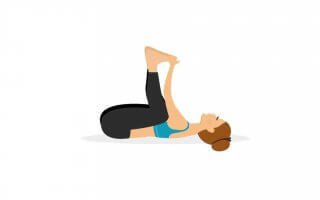
To do this exercise:
- Place a yoga mat or thick towel down flat on the floor.
- Lie on the mat on your back, and draw your knees in towards your chest.
- Hold on to your knees, inhale deeply & exhale.
- Grab the outside edges of your feet, or wrap your index and middle around your big toes, and pull your knees (bent) out to the side.
- Try to pull the knees as closely to the floor as you can without causing any discomfort.
- Pull your feet back with your hands.
- Tighten your tummy
- Rock from side to side to give your back a lovely massage.
- Hold
- Release your legs straight to the floor gently, with your arms at your side to relax.
Locust pose (Salabhasana)
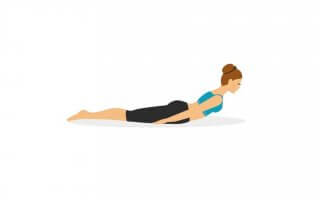
This posture works both the glutes, buttocks & the pelvic floor – 3 for the price of 1!
To do this:
- Lie flat on your tummy on your mat, with your legs together and your arms at your sides.
- Rest your nose & forehead gently on your mat.
- Inhale and lift your head, chest, arms, knees and feet off the floor.
- Squeeze your tummy muscles, glutes & buttocks to help lift everything up off the floor.
- Keep your legs straight out, hold for about 30 seconds, and then gently release back down.
- Repeat.
Boat pose (Navasana)
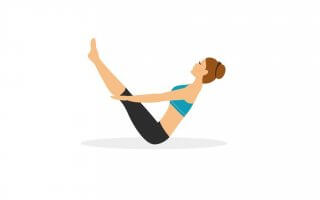
To do this:
- Start sitting on the floor with both knees as close as possible to the chest, hands behind the knees.
- Point the toes, feel the ground with both sitting bones, take a deep breath in and push the chest towards the knees, keep the shoulders away from the ears.
- Exhale and lift both feet up until parallel to the ground.
- Keep pushing the chest towards the knees.
- Stay for 5 breaths.
- Options: You can keep your hands behind the knees for support or extend both arms forward. You can keep the knees bent or straighten both legs.
- Watch out: do not curve the spine and fold in, keep pushing the chest forward trying to reduce the gap between the chest and the thighs.
Yoga squat (Malasana)
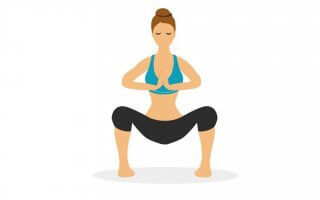
To do this:
- Start in your forward fold with both hands down, shoulder distance apart and feet hip distance apart.
- Turn the toes to face out 45 degrees angle.
- Bend the knees and lower your hips toward the floor.
- Lift the chest.
- Lift both hands and press the palms together in front of your chest.
- Push the elbows into your inner thighs and lift the chest a bit more.
- Remember to keep your spine long, keep your shoulders away from the ears, shoulder blades towards each other, and the neck is long.
Bridge (Setu Bandha Sarvangasana)
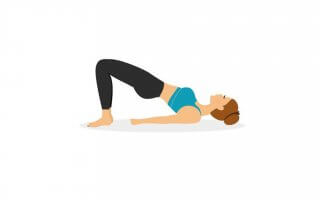
To do this:
- Start lying down on your back, arms alongside the body with palms facing down.
- Bend the knees and place the heels as close as possible to your sitting bones, feet hip distance apart.
- If you have a block, place it between your knees.
- Turn the toes slightly in.
- Take a deep inhale and on the exhale tuck the tailbone under, engage the glutes and lift your hips and chest up.
- Squeeze the block between the knees.
- Think about elongating your spine and start actively pressing the palms and the forearms down on the mat to find more lift.
- Look up at the ceiling.
- Five breaths.
The breath is king!
To breathe efficiently the pelvic floor must be involved, and to exercise your pelvic floor efficiently, the breath must be involved. Your pelvic floor moves in a dance with your diaphragm when you breathe. When we breathe in, the diaphragm moves down, and so does the pelvic floor; when we breathe out, they both move up. Start observing this connection and then start bringing the focus to your pelvic floor. Inhale and keep your pelvic floor relaxed, exhale and engage your pelvic floor by lifting it – How? Imagine you are holding a wee. With a bit of practice, you can begin to accentuate each end of the breath cycle, relaxing and engaging, relaxing and engaging,
Interested in some more pelvic floor exercises? Check out Innovo’s invisible workouts; a series of podcasts which can help you strengthen your pelvic floor no matter where you are.









